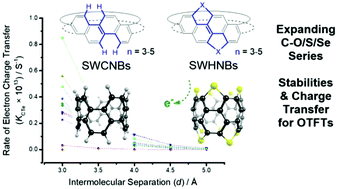Oxygen, sulfur and selenium terminated single-walled heterocyclic carbon nanobelts (SWHNBs) as potential 3D organic semiconductors†
Abstract
Carbon nanomaterials such as polyaromatic hydrocarbons (PAHs), graphene, fullerenes and nanotubes are on the frontline of materials research due to their excellent physical properties, which in recent years, have started to compete with conventional inorganic materials in charge transfer based applications. Recently, a variety of new structures such as single-walled carbon nanobelts (SWCNBs) have been conceived, however, to date only one ‘all-phenyl’ example has been synthesised, due to problems with their stability and the challenging synthetic methodologies required. This study introduces a new class of phenacene-based SWCNBs and their chalcogenide derivatives, forming the new sub-class of single-walled heterocyclic carbon nanobelts (SWHNBs) which are expected to be both more stable and easier to synthesise than the all carbon analogues. Subsequent theoretical examination of the structure–property relationships found that unlike the small-molecule acene homologues (tetracene, pentacene etc.) which become more reactive with addition of oxygen, an increase in the molecular size of the SWCNBs actually stabilises the HOMO energy level, in correlation with the increasingly negative nuclear independent chemical shift (NICS) calculations of their cylindrical aromaticities. The FMO energies of the phenacene SWCNBs are similar to that of the nanobelt reported by Itami and co-workers, but those of the SWHNBs are deeper and thus more stable. The sulfur derivative of one SWHNB was found to give hole-charge transfer mobilities as high as 1.12 cm2 V−1 s−1, which is three orders of magnitude larger than the corresponding unsubstituted SWCNB (3 × 10−3 cm2 V−1 s−1). These findings suggest the candidates are air-stable and potentially high-performing organic semiconductors for organic thin film transistor (OTFT) devices, while the structure–property relationships uncovered here will aid the design and synthesis of future three-dimensional organic nanomaterials.



 Please wait while we load your content...
Please wait while we load your content...